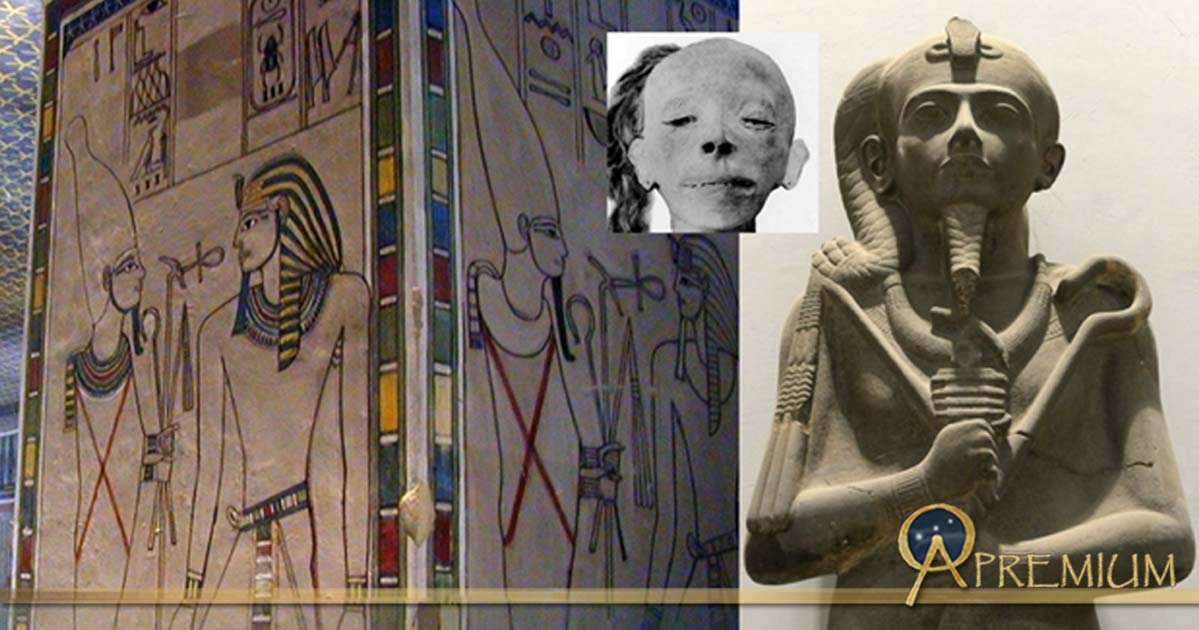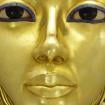Puzzle of the Unidentified KV35 Mummy: Boy Kings and the Specter of Smenkhkare—Part II
The staggering number of royal mummies that Victor Loret found in the final resting place of the Eighteenth Dynasty pharaoh, Amenhotep II, consisted of some individuals who have not yet been positively ascertained. Prime among them was the body of a young boy who has been identified variously by Egyptologists, with Prince Webensenu topping the list of probable candidates. Are we accurate in our findings, or is a DNA test required to solve the matter conclusively?

A boulder on Sehel Island, near Aswan, is inscribed with the prenomen of Amenhotep II - “Aakheperure". (Photo: HoremWeb/CC BY-SA 3.0)
WHO WAS WEBENSENU?
Even though Loret firmly believed that his identification of the mummy of the boy found in between those of two Amarna period royal women, as Prince Webensenu, was beyond doubt, we know that circumstantial evidence alone cannot aid in positively recognizing ancient Egyptian deceased. The existence of a shabti inscribed with Webensenu’s name (that was probably discovered on the steps of antechamber F which led down to corridor G and the burial chamber), and fragments of a canopic set of this prince were all that Loret had to go by in making his mind up about the unidentified child.

The faces on most statues of Amenhotep II differ slightly from those of his two immediate predecessors. This red granite face is not a portrait, but an official image conceived by the chief royal sculptors to communicate the ideal physical appearance of the king. Brooklyn Museum. (Photo: Keith Schengili-Roberts/CC BY-SA 2.5)
However, the idea that this is the mummy of an Amarna prince, perhaps the enigmatic Smenkhkare himself, finds support from no less than Sir Grafton Elliot Smith, in a roundabout way. He examined the mummy and agreed with Loret that it was probably the mummy of Webensenu. What’s key though is the fact that Smith also made what is now viewed as a sensational claim about this mummy in his 1912 book “The Royal Mummies”: “(It) is a small boy (1 m. 242 mill.) whose general appearance is suggestive of an age of about nine or ten years: but as permanent canine teeth are present and fully grown he cannot be less than eleven years of age.”

Reconstruction of a photo of the mummy of the mysterious boy, sans the deep gash on his neck and jaw. (Right) Artist’s impression of how the child may have appeared whilst alive. This has led to comparisons with Tutankhamun’s Khonsu statue. (Photos and art: G. Elliot Smith - Wikimedia Commons; and Tutankhaten-pasheri)
For long, a section of scholars has proposed that back-to-back boy kings ruled Egypt from the new capital Akhetaten after the death of Pharaoh Akhenaten. With Smith’s indications of age firmly in place, it could well be that Smenkhkare probably ascended the throne at about the same age as his possible brother and eventual successor, Tutankhamun. Smith recorded that the boy’s ears had been pierced and also that he was uncircumcised. Both arms of this mummy were extended and placed over the pubic area. The anatomist reports that the left hand was clenched, but that the thumb of this hand was extended. In addition to the hole in the skull, plunderers had made a large gash in the left side of the boy’s neck and thorax. Barring these indignities, the unidentified mummy was in a rather good state of preservation.

The Australian-British anatomist, Sir Grafton Elliot Smith, rendered yeoman service in Egyptology by studying mummies from different dynasties. His findings are well-regarded and crucial to our understanding, particularly of royal personages. (CC BY 4.0)
PROXIMITY TO ROYALTY
Loret took a photograph of these mummies in situ, which reveals that they were unwrapped in antiquity and only partly re-covered—that too in a careless manner in what appeared to be the remnants of their bandages.
This FREE PREVIEW is just a taste of the great benefits you can find at Ancient Origins Premium.
Join us there ( with easy, instant access ) and reap the rewards: NO MORE ADS, NO POPUPS, GET FREE eBOOKS, JOIN WEBINARS, EXPEDITIONS, WIN GIFT GIVEAWAYS & more!
- Tutankhamun and the Age of Appropriation: Priceless Secrets and Palimpsests Hidden in Plain Sight–Part I
- Life after Life: In the Quest for Eternity, Death is Only the Beginning – Part I
- The Many Mysteries of Maya: On the Trail of Tutankhamun’s Valued Courtier–Part I
Independent researcher and playwright Anand Balaji is an Ancient Origins guest writer and author of Sands of Amarna: End of Akhenaten.
--
Top Image: Collection of Egyptian Art, design by Anand Balaji (Photo credits: Richard Dick Sellicks, Dave Rudin, G. Elliot Smith/Wikimedia Commons); Deriv.
By Anand Balaji



















Comments
Well, I'm glad that some people remember the posts I made on that rather poisonous forum some years back :)
As some idle speculation, it could be than some Egyptologists and other commentators deliberately turn a blind eye to this prince, and many other aspects of AE if it does not fit with their view of what should be. That this prince is dismissed as Webensenu without any apparent thought into the context of who he is buried with is, bizarre...
Also, though Hawass is no longer head of SCA, it cannot be discounted that as the rule of Sissi is essentially a continuation of Mubarak's administration, that he wields some behind the scenes influence. Hawass is adamant that KV55 is Akhenaten, and I think that if the DNA of this prince should show him to be a son KV55 and brother of Tutankhamun, then notwithstanding the extremely skimpy evidence for male children of kings at that time, and of mention of any brothers of reigning kings, it could, and only could, suggest that Akhenaten did not in fact produce a male heir, but that Smenkhare, if he is his younger brother and not elder son or Nefertiti, did, and at least two. It is very difficult to think of any reason not to release the DNA results other than that they are, for whatever reason, inconvenient.
Also despite the almost invisibility of male royal children, there is enough to show that at least crown princes get some mention. Tuthmosis IV, Amunhotep III, prince Thutmosis and Amunhotep IV/Akhentaten are mentioned before becoming king, but zero for Smenkhare and Tutankhaten. I suspect that Tutankhaten was born as the son of a prince, Smenkhare, who never expected to be king. But in this weird world of Amarna is is entirely possible that Smenkhare and Tutankhaten are both sons of Akhenaten, and despite the non crossed arms of the KV35 prince, he is Smenkhare, KV55 is Akhenaten and Nefertiti is, where.....
Hello there, Tutankhaten-pasheri. First up, I wish to thank you for the amazing reconstruction of the KV35 boy. I don't know why you call it a "rather crude reconstruction" :-)
Your artistic rendition is the best available on the Internet; and in fact, it is the only one of its kind. My article would not have appealed so much to readers, had it not been for this brilliant artwork.
Oh yes, the Amarna period is baffling; as we have several personages who have earned the tags "mysterious" and ephemeral". Will we ever learn the truth about this Prince? Only time will tell.
Well, by accident I arrive here and find my rather crude reconstruction, I am no artist... Anyway, flattering to see it used and me given a mention.
It is about four years since I wrote about this mummy, and all the questions I raised then are still unresolved. SCA have his DNA results and could at least announce who he is related to, but silence, why?. On various other sites and in various publications there are lists of which 18th dynasty royal mummies were DNA tested in about 2010 or earlier. This mummy does not appear on any list, but he was tested, and there are photos from National Geographic showing Hawas and two assistants taking samples from him. Despite the fragments of canopic vessels for Webensenu and that a toe of the unknown prince was found in another, unspecified, area of KV35, due to his placement between Queen Tiye and Tutankhamun's mother must, I think, mitigate strongly that he is very closely related to them. Without going into the debate about whether KV55 is Akhenaten or Smenkhare, the non royal placement of the KV35 mummy's arms indicates, sadly, that he is very unlikely to be Smenkhare, even if that is an intruiging thought to play with. I doubt he is crown prince Thutmosis either, as I think Thutmosis would have been a young man at the time of his death, possibly even in his mid twenties or older. He died around Amunhotep's year thirty, so unless one or more totaly unknown previous crown princes had been born in the early years of Amunhotep's reign, then all died leaving a much younger Thutmosis to become crown prince, and this is of course possible and the family of Ramesses II show this, I think this unknown prince is somebody else. We all know that evidence for princes in the 18th dynasty is extremely skimpy, and Tutankhaten appears from nowhere at the death of Smenkhare. That Thutmosis exists in images at Karnak and some burial equipment, the shabti of him as high priest of Ptah and the coffin of his cat for instance, indicates to me that Thutmosis may well have been the first and only heir to Amunhotep III until he died and the future Akhenaten took over that role. That this burial equipment was found at Saqqara, which fits with him being high preist of Ptah and in connection with the first Apis bull burial, also indicates that the prince in KV35 is unlikely to be Thutmosis. If so, why disturb his Saqqara burial to move him to Thebes?
Until the DNA results are released, I work on the presumption that he is either an unknown son of Amunhotep III, Akhenaten or Smenkhare, if "he" is not Nefertiti as suggested by Nicholas Reeves. Without positive evidence for, I am still of the opinion that he may be a brother of Tutankhaten, but whether older or younger I do not know. I also find it intruiging that while murder with an axe or sword has been suggested as a cause of death for Tutankhamun's mother, the large gash in her face may have been caused by a horses hoof. The large hole in the prince's thorax seems, according to University of York forensic examination, to have been caused before the mummy was wrapped. This is indicated, as it is with the wound to Tutankhamun's mother, by no linen fragments being found in the wound, as they would have had if the damage was done by tomb robbers. It is posited that the damage, caused by at least five blows, if not the cause of death, was a malicious act carried out after death and before mummification. Of course all three mummies in the side chamber had been damaged by robbers as well, but the pre mummification face injuries of the woman and thorax injuries of the boy suggest, what?
Also, this prince has severe internal skeletal injuries. The head of his right femur has been dislocated from the hip socket and there are fractures in other areas of his pelvis and some less severe damage to his left hip. It is thought these injuries occured in life. To me, it seems not impossible that this prince and Tutankhamun's mother have died in unusual and violent circumstances, and this links the prince more closely to Tutankhamun's mother than to Queen Tiye, who shows no damage other than from robbers, and who I am sure died of old age. But this is Amarna, anything is possible.....